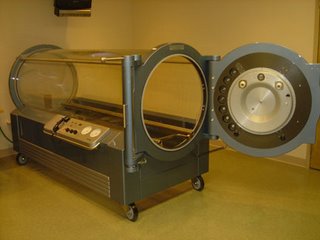Knowledge Is Power
 My biggest writing project of this year has been a monograph on hyperbaric oxygen therapy. It should have been finished by now, but what a can of worms! I was too ignorant to be intimidated when I accepted the assignment. Only later did I learn that it was originally conceived by the publishers as having no less than eight authors. Many experts are unwilling to talk to me because the subject is so controversial. The material I'm wading through is extremely technical, and covers a multitude of medical fields. I sit like a foreign student, surrounded by dictionaries and reference books, getting hung up over every incomprehensible abbreviation on a graph, every citation directing me to a journal I can't access.
My biggest writing project of this year has been a monograph on hyperbaric oxygen therapy. It should have been finished by now, but what a can of worms! I was too ignorant to be intimidated when I accepted the assignment. Only later did I learn that it was originally conceived by the publishers as having no less than eight authors. Many experts are unwilling to talk to me because the subject is so controversial. The material I'm wading through is extremely technical, and covers a multitude of medical fields. I sit like a foreign student, surrounded by dictionaries and reference books, getting hung up over every incomprehensible abbreviation on a graph, every citation directing me to a journal I can't access.I'm supposed to be writing this for a lay audience, but in fact the monograph will be read by many medical professionals, and of course reviewed before it's ever published by an editorial board of experts. It's like the term paper from hell, only longer.
At the moment, I'm working on a section describing the approved indications for HBOT. That is, the conditions Medicare and most insurance companies will pay to treat. The use of HBOT is extremely controversial for certain conditions, but not for these. My logic is that, if the pathophysiology and treatment mechanism are understood for these approved, non-controversial conditions, a compelling case for the use of HBOT in other areas can be made if it can be shown that the same underlying disease processes are at work.
Working on this monograph is forcing me to spend a lot of time reading and writing about some pretty creepy diseases and conditions, like necrotizing soft tissue wounds, gas gangrene, and crush injury. Another scary one is air embolism. That's when air bubbles get into the bloodstream and act like a blood clot. The commonest cause is surgery or other invasive medical procedures. If the patient is reclining, air is more likely to enter the coronary arteries; if the patient is upright, air is more likely to enter the cerebral arteries.
Procedures with a known risk of air embolism, like open heart surgery, should be performed in facilities with hyperbaric chambers available. Putting a patient in a chamber pressurized to 6ATA (six times the pressure at sea level) reduces the size of the air bubbles by six, allowing them to pass through the blood vessels. Time is of the essence, since a blocked blood vessel can result in stroke, hypoxia, edema, and also unleash a chain of biochemical reactions: prostaglandin release, leukocyte activation, and so on.
On the up side, I'm learning a lot. Knowledge is power, right? The main thing I learned today was, try not to get sick and need surgery.


0 Comments:
Post a Comment
<< Home